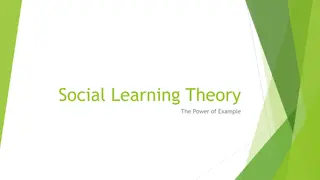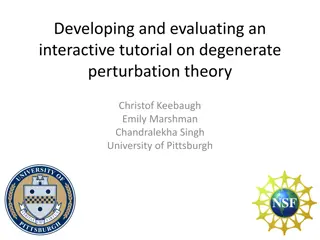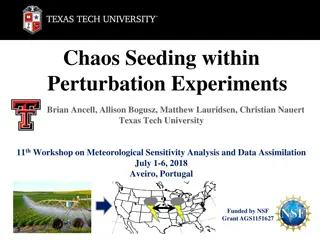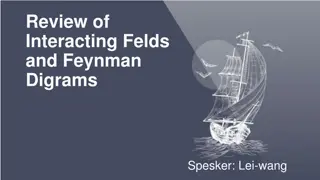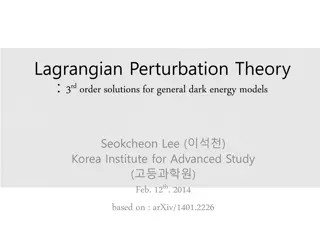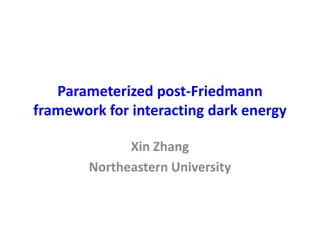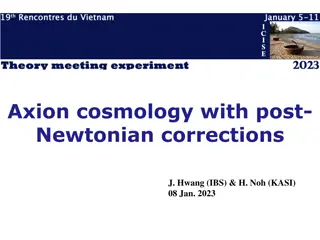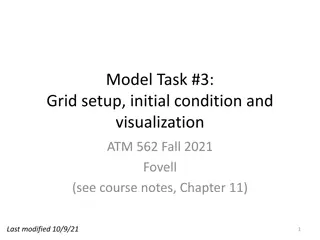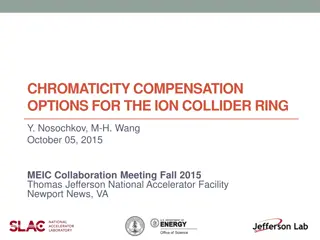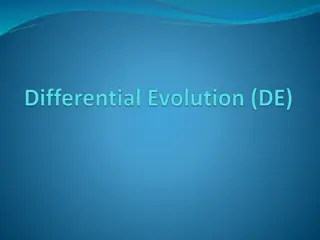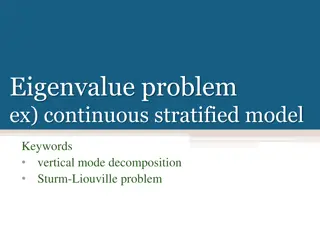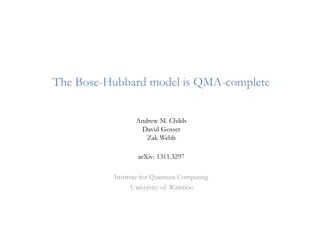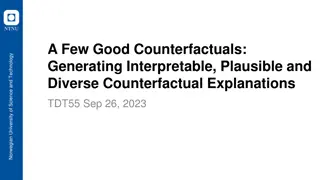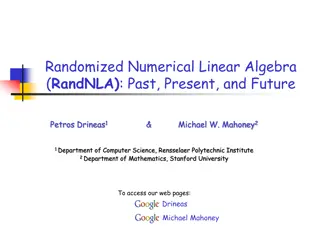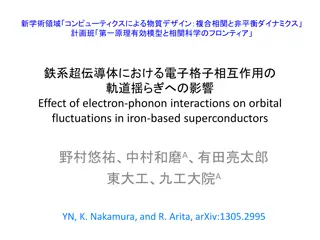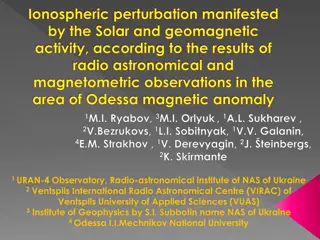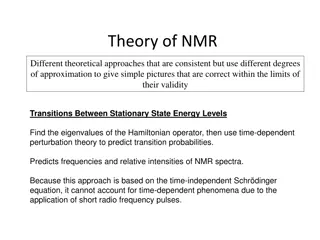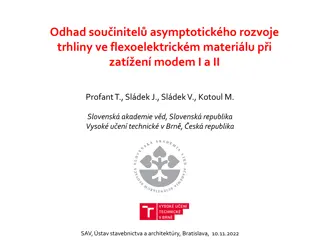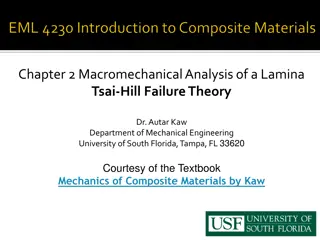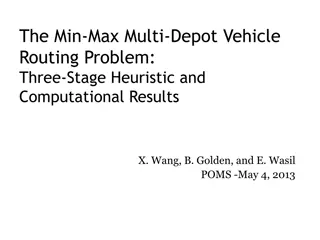Ginzburg Landau phenomenological Theory
The Ginzburg-Landau phenomenological theory explains superconductivity and superfluidity as distinct thermodynamic phases. It focuses on phase transitions characterized by singularities in specific heat at the transition temperature. Derived from BCS theory, it quantifies condensation energy, emphas
1 views • 38 slides
Crystal Field Theory in Transition Metal Complexes
Crystal Field Theory (CFT) explains the colors and magnetic properties of transition metal complexes. It focuses on the energy changes in d-orbitals of metal ions caused by surrounding ligands. This theory, developed in 1929, provides insights into the bonding interactions in complex compounds. The
10 views • 44 slides
Understanding Social Learning Theory and the Power of Example
Social Learning Theory, introduced by Bandura, emphasizes learning through observation and modeling. It explores how individuals acquire behavioral dispositions, trial-and-error experiences, and the impact of stimuli in the environment. The theory focuses on the importance of attention, retention, a
1 views • 17 slides
Earth-GRAM Overview and Updates 2023
Earth-GRAM is a global reference atmospheric model providing monthly mean and standard deviation data for various atmospheric variables. It is used in engineering for dispersion simulations but is not a forecasting model. Updates to Earth-GRAM include the Modern Era Retrospective Analysis, a global
0 views • 19 slides
Evolution of Mathematical Theories and Proof Systems
Development of mathematical theories such as model theory, proof theory, set theory, recursion theory, and computational complexity is discussed, starting from historical perspectives with Dedekind and Peano to Godel's theorems, recursion theory's golden age in the 1930s, and advancements in proof t
1 views • 29 slides
Psychological Theories of Criminality: Understanding the Roots
Psychological theories of criminality delve into the association between intelligence, personality, learning, and criminal behavior. Major theories include Psychodynamic Theory by Freud, Behavioral Theory by Bandura, and Cognitive Theory by Kohlberg. These theories explore how unconscious mental pro
1 views • 20 slides
Understanding the Theory of Firms: Neoclassical vs. Modern Approaches
The theory of firms is explored through the Neoclassical and Modern perspectives. Neoclassical theory focuses on profit maximization, while Modern theory delves into managerial, principal-agent, and transaction cost theories. The discussion covers criticisms of Neoclassical theory and the essential
1 views • 79 slides
Theories of Causation in Psychological and Social Sciences
Overview of theories of causation categorized into psychological, social psychological, and sociological perspectives. Psychological theories focus on instinctive, biological, and psychological qualities of abusers, including Attachment Theory, Psychodynamic Theory, Social Learning Theory, and Situa
0 views • 15 slides
Understanding Political Theory through a Contextual Approach
Exploring G.H. Sabine's perspective on political theory through a contextual approach, emphasizing the importance of historical context and societal influences. Sabine argues that while political theory evolves with its contemporary politics, it should be analyzed within its specific time and social
0 views • 9 slides
Evolution of Light Theory: From Wave Theory to Quantum Theory
At the turn of the century, the discovery of the photoelectric effect challenged the wave theory of light, leading to the development of the quantum theory by Max Planck and Albert Einstein. This new theory introduced the concept of discrete energy units known as quanta, bridging the gap between wav
1 views • 62 slides
Understanding Feynman Diagrams in Particle Physics
Feynman diagrams, developed by Richard Feynman in the 1940s, are a graphical technique to represent particle interactions in space-time. These diagrams use lines to depict particles, with fermions moving forward in time and antifermions moving backward. Vertices in the diagrams represent points wher
1 views • 19 slides
Interactive Tutorial on Degenerate Perturbation Theory: QuILT Development and Student Difficulties
Developing an interactive tutorial on Degenerate Perturbation Theory (DPT) to aid students in understanding the challenging synthesis of Quantum Mechanics concepts with Linear Algebra. The tutorial focuses on addressing common student difficulties, such as identifying good bases, diagonalizing matri
0 views • 12 slides
Dp-branes, NS5-branes, U-duality, and M-Theory Overview
Overview of Dp-branes, NS5-branes, and U-duality derived from nonabelian (2,0) theory with Lie 3-algebra. Introduction to M-theory, including M2-branes and M5-branes in the strong coupling limit. Discussion on BLG theory, Lorentzian Lie 3-algebra, and the ABJM theory for M2-branes.
1 views • 32 slides
Understanding Time-Independent Perturbation Theory in Quantum Mechanics
Perturbation theory is a powerful tool in solving complex physical and mathematical problems approximately by adjusting solutions from a related problem with known solutions. This theory allows for more accurate approximate solutions by treating the difference as a small perturbation. An example inv
0 views • 19 slides
Investigating Chaos Seeding in Perturbation Experiments
This research project conducted at Texas Tech University delves into the effects of chaos seeding within perturbation experiments on atmospheric conditions, with a focus on local and nonlocal modifications resulting from factors such as irrigation, wind farms, and urban development. By analyzing tin
0 views • 24 slides
Understanding Interacting Fields and Feynman Diagrams in Quantum Field Theory
Delve into the fascinating world of quantum field theory with a focus on interacting fields and Feynman diagrams. Explore perturbation theory, correlation functions, Wick's theorem, and Feynman diagram rules to gain insights into preserving causality, calculating two-point correlation functions, and
0 views • 18 slides
COTEKINO Priority Project Summary
COTEKINO Priority Project involved developing and testing perturbation methodologies for convection-permitting ensembles across various operational weather services. Tasks included deriving perturbations, testing models, and coordinating with different agencies. The project aimed to enhance forecast
0 views • 9 slides
Lagrangian Perturbation Theory: Applications in Cosmology
Lagrangian Perturbation Theory (LPT) offers solutions for general dark energy models and is crucial for upcoming large-scale surveys. It provides a method to displace particles at large scales efficiently. While Standard Perturbation Theory (SPT) is limited at linear order, LPT overcomes its drawbac
0 views • 14 slides
Exploring Parameterized Post-Friedmann Framework for Interacting Dark Energy
Dive into the complexities of considering interacting dark energy (IDE) using a parameterized post-Friedmann framework. Learn why IDE is essential, how to detect couplings, calculate perturbation evolutions, and address instability issues. Explore the one-parameter extensions like wCDM and I.CDM, an
0 views • 18 slides
Understanding Axion Cosmology with Post-Newtonian Corrections
Exploring axion cosmology with post-Newtonian corrections, this study delves into linear density perturbations for dust, the role of axion as a cold dark matter candidate, and fully nonlinear perturbation formulations. It addresses continuity, momentum conservation, and quantum stress to identify ke
0 views • 22 slides
Atmospheric Modeling Task with Initial Conditions and Grid Setup
Create a model grid with 2D arrays for prognostic variables, set initial dry and adiabatic environmental conditions, introduce thermal and pressure perturbations, and visualize using GrADS. Define variables like velocities, perturbation temperature, and pressure fields, along with base state variabl
0 views • 27 slides
Chromaticity Compensation Options for the Ion Collider Ring
The MEIC Interaction Region faces challenges due to high beta functions causing chromatic perturbation. To address this, local compensation through Chromaticity Compensation Block (CCB) with sextupoles is proposed. Three CCB options are presented for consideration. The report explores the impact of
0 views • 17 slides
Understanding Differential Evolution: An Overview of the DE Algorithm
Differential Evolution (DE) is an Evolutionary Algorithm (EA) proposed for continuous function optimization. It uses vector differences to perturb the population, deviating from traditional crossover and mutation methods. DE involves mutation, perturbation, and various mutation schemes like DE/rand/
0 views • 20 slides
Governing Equations and Model Reduction in Continuous Stratified Models
Detailed analysis of the governing equations in a continuous stratified model with vertical mode decomposition and Sturm-Liouville problem. The density perturbation and pressure perturbation are examined to derive a reduced 3D system. The Boussinesq approximation and hydrostatic balance are applied,
0 views • 36 slides
Understanding Computational Complexity in Quantum Hamiltonians
The Bose-Hubbard model is proven to be QMA-complete, indicating the challenge in solving ground energy problems in quantum systems. Various classes of Hamiltonians, such as k-local and stoquastic, exhibit different complexities in computing ground energy. While some systems with QMA-complete ground
0 views • 40 slides
Enhancing Counterfactual Explanations for Improved Understanding
This article explores the concept of generating interpretable, diverse, and plausible counterfactual explanations within explainable AI (XAI). It highlights the challenges with current methods, introduces an instance-guided approach, and emphasizes the importance of good counterfactuals. The discuss
0 views • 22 slides
Exploring Randomized Numerical Linear Algebra (RandNLA)
Delve into the world of RandNLA, where randomization and sampling techniques are utilized to design accurate algorithms for handling massive matrices and computationally complex problems. Learn about sampling rows/columns, matrix perturbation theory, and its applications in Big Data, theoretical com
0 views • 83 slides
Understanding Degenerate Perturbation Theory in Quantum Mechanics
Exploring time-independent perturbation theory, specifically focusing on non-degenerate and degenerate spectra. The lecture covers approximation schemes, treatment of multi-electron atom term values, and the effects of spin-orbit interaction. Concepts include evaluating expectation values, wavefunct
0 views • 13 slides
Understanding Electron-Phonon Interactions in Iron-Based Superconductors
This discussion explores the effects of electron-phonon interactions on orbital fluctuations in iron-based superconductors. Topics covered include ab initio downfolding for electron-phonon coupled systems, evaluation methods such as Constrained Random Phase Approximation (cRPA), Constrained Density-
0 views • 12 slides
Ethical Theories: Divine Command vs. Virtue Theory Explained
Divine Command Theory asserts that morality is derived from God's commands, contrasting with Virtue Theory which focuses on developing moral virtues to achieve human flourishing and excellence. Divine Command Theory relies on religious texts, while Virtue Theory emphasizes the cultivation of virtues
0 views • 24 slides
Understanding Fermi Liquid Theory in Interacting Fermion Systems
Fermi liquid theory, also known as Landau-Fermi liquid theory, is a theoretical model that describes the normal state of metals at low temperatures. Introduced by Landau and further developed by Abrikosov and Khalatnikov, this theory explains the similarities and differences between interacting ferm
0 views • 23 slides
Computational Learning Theory: An Overview
Computational Learning Theory explores inductive learning algorithms that generate hypotheses from training sets, emphasizing the uncertainty of generalization. The theory introduces probabilities to measure correctness and certainty, addressing challenges in learning hidden concepts. Through exampl
0 views • 43 slides
Automata Theory and Theory of Computation Overview
This course overview covers concepts in automata theory and theory of computation, including formal language classes, grammars, recognizers, theorems in automata theory, decidability, and intractability of computational problems. The Chomsky hierarchy, interplay between computing components, modern-
0 views • 42 slides
Theories of Interest in Microeconomics II
Explore various theories of interest in economics, including the Classical Theory, Liquidity Preference Theory by Keynes, Productivity Theory, Abstinence Theory, Time-Preference Theory, Fisher's Time Preference Theory, and the Loanable Fund Theory. These theories offer different perspectives on the
0 views • 6 slides
Exploring the Evolution of Atomic Theory
Delve into the historical journey of atomic theory starting from Democritus and Aristotle's views to modern advancements proving some aspects of Dalton's theory incorrect. Learn about key laws and theories such as the Particle Theory of Matter, Dalton's Atomic Theory, and JJ Thomson's discoveries, s
0 views • 30 slides
Study on Ionospheric Perturbation Due to Solar and Geomagnetic Activity in Odessa Magnetic Anomaly
Research conducted in the area of the Odessa magnetic anomaly investigates ionospheric perturbations caused by solar and geomagnetic activity. The study utilizes radio astronomical and magnetometric observations from various observatories, highlighting the significance of the geomagnetic anomaly nea
0 views • 18 slides
Insights into Theoretical Approaches in NMR Spectroscopy
Theoretical approaches in NMR spectroscopy encompass diverse methods, each with varying degrees of approximation but yielding correct results within their validity. Techniques such as transition probabilities using the time-dependent perturbation theory, Zeeman interaction for energy level transitio
0 views • 32 slides
Understanding Flexoelectric Materials and Their Asymptotic Behavior in Crack Development
Explore the utilization of asymptotic approaches to analyze crack development in flexoelectric materials, considering the influence of intensity of applied stress, limitations, advantages, and the connection to singular perturbation methods. Discover the intriguing property of flexoelectric material
0 views • 17 slides
Macromechanical Analysis of Lamina and Tsai-Hill Failure Theory Overview
The Tsai-Hill failure theory is based on the strengths of a unidirectional lamina, incorporating longitudinal and transverse tensile and compressive strengths, as well as in-plane shear strength. This theory, derived from the distortion energy theory, provides criteria for determining lamina failure
0 views • 15 slides
Heuristic Approach for the Min-Max Multi-Depot Vehicle Routing Problem
This study explores a three-stage heuristic to solve the Min-Max Multi-Depot Vehicle Routing Problem (MDVRP), aiming to minimize the maximum distance traveled by vehicles. It covers an introduction to the problem, literature review, the importance of the min-max objective, and a heuristic solution m
0 views • 21 slides


